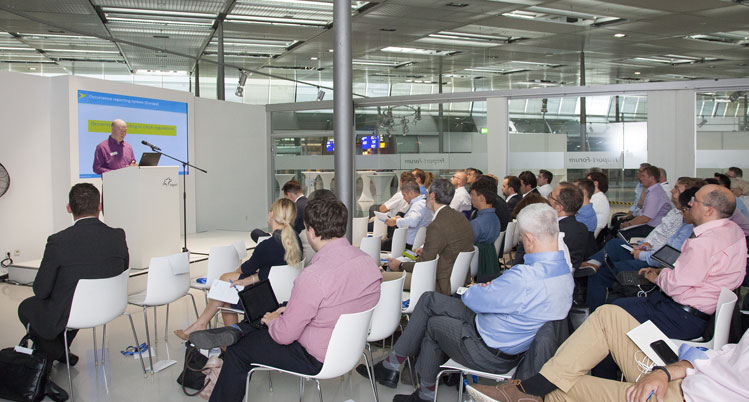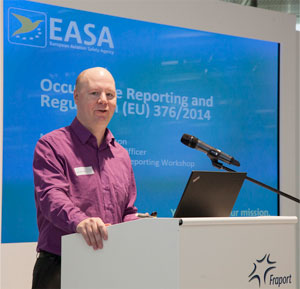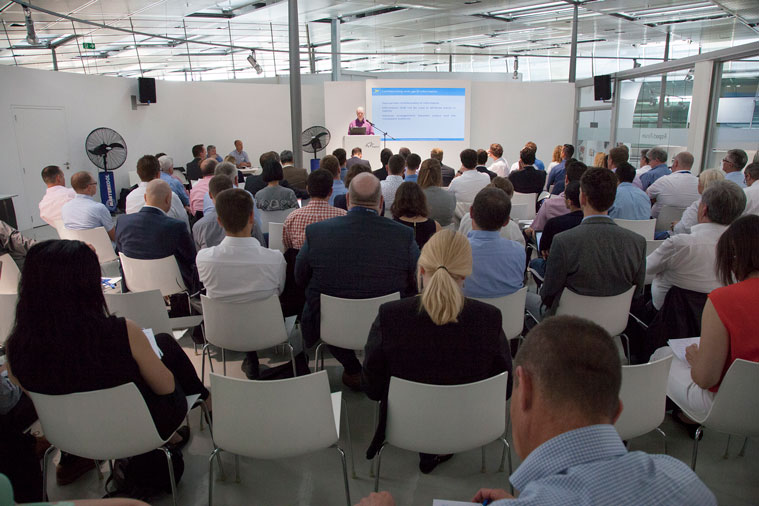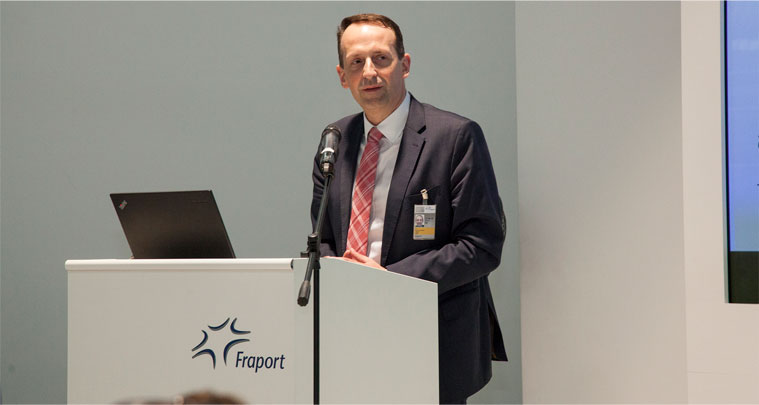The Occurrence Reporting regulation in the EU has been in place for a number of years. However, implementation and practices vary significantly across EASA’s 32 member states. Almost 100 representatives of airports, airlines, and national aviation authorities gathered at Frankfurt Airport on 14 June for a one-day workshop to share their views and questions on Occurrence Reporting. By John Franklin

Almost 100 representatives of airports, airlines, and national aviation authorities gathered at Frankfurt Airport on 14 June for a one-day workshop to share their views and questions on Occurrence Reporting.

Martin Bernandersson, Safety Analysis Officer at EASA.
Regulation (EU) 376/2014 on the reporting, analysis and follow up of occurrences in civil aviation will be well known to anyone involved in the safety side of the airport business. The European Commission led the development of this regulation, which has been in force since 2015, as well as the Commission Implementing Regulation 2015/1018 listing the mandatory reportable occurrences. Through EASA’s collaborative work with the airport and ground handling community both ACI EUROPE and EASA had agreed that further efforts to strengthen and support improved implementation on Occurrence Reporting would be a great initiative. Furthermore, in the spirit of collaboration, both organisations were keen to raise awareness about how the analysis of occurrences is an important driver for future safety mitigations and initiatives at strategic level.
This led to a gathering of almost 100 representatives of airports, airlines and national aviation authorities at Frankfurt Airport on 14 June for a one-day workshop to share their views and questions on the intricacies of Occurrence Reporting and the important role it plays in Safety Management. The workshop was hosted by Fraport AG, EASA and ACI EUROPE as a joint event to enable stakeholders to share their experiences on implementing the regulation. The workshop also provided the chance to outline how the Aerodromes and Ground Handling Collaborative Analysis Group (CAG) brings together community stakeholders to analyse safety occurrences to help drive the mitigations in the European Plan for Aviation Safety (EPAS). Through this collaborative effort the community works together to identify the main safety priorities for airports and ground handling in the domain Safety Risk Portfolio. Further analysis of the top safety issues then leads to the identification of mitigations for the EPAS. An important message is that the more information that is provided in occurrence report, the more information there is to support this collaborative analysis activity and therefore to drive future safety initiatives.

The workshop was hosted by Fraport AG, EASA and ACI EUROPE as a joint event to enable stakeholders to share their experiences on implementing the regulation.
The workshop highlighted some specific areas for further work within the collaborative efforts described. These included:
Understanding and Awareness of the Occurrence Reporting Process
- The workshop discussed the challenges airports face in interpreting the Regulation and understanding what is expected within the process of occurrence reporting. These included the reporting timelines, knowing what types of events should be reported and the need for parallel reporting of the same event by different stakeholders were consistent themes during the presentations and discussion that followed. Such questions were raised by airports, airlines and authorities alike.
- In these areas, EASA and national aviation authorities are continually working on ways to help streamline the reporting process through the electronic transfer of reports in ECCAIRS (European Co-ordination Centre for Accident and Incident Reporting Systems) format. Airports are encouraged to seek assistance from EASA or their national authority if they have any questions or problems with regards to these electronic processes.
- For the parallel reporting streams from different stakeholders for the same occurrence, EASA highlighted the importance of receiving the different viewpoints on reportable occurrences. The different reports were critical for effective analysis of key risks and to help identify the best mitigations. While there might be a general perception that reports disappear into a “black hole”, they are in fact collated into the European Central Repository (ECR), managed by the European Commission, which is a vital source of information for the collaborative analysis activities described earlier.
- The workshop helped provide a better understanding about the topics for which more information and guidance is needed. This will help to shape future Safety Promotion material on Occurrence Reporting and also to help inform the European Commission on different ways to improve the implementation of the Regulation.

Dr. Dominique Prümm, General Manager Aviation, Airside and Terminal Management, Corporate Safety and Security, Fraport AG.
European Aviation Safety Reporting Portal
Reporting of occurrences should be done directly via the European Aviation Safety Reporting portal: www.aviationreporting.eu
This portal provides common reporting forms for organisations and individuals to report to their competent authority, including the Agency, using a common and simple interface. This solution is meant for any individuals or organisations, in particular those organisations having a low number of occurrence reports per year.
Using Occurrences as Part of a Data-Driven Approach to Safety Decision Making
During the workshop airports expressed an interest in having greater access to the collective data set of occurrences by reported stakeholders into the ECR. Many airports are not aware that they can request aggregated safety information from the European Central Database through their national aviation authorities and EASA will promote this service more in the future.
Additionally, there was an interest for airports (and other stakeholders) to have more information on the analysis of safety issues in airport operations to support the Safety Management Systems of their own organisations. With the establishment of the Aerodromes and Ground Handling CAG, the subsequent results of analysis and Safety Risk Management activity will be made more widely available to stakeholders as part of the Agency’s updated Safety Promotion Plan. The first example of this is in the EASA Annual Safety Review 2018 (https://www.easa.europa.eu/document-library/general-publications/annual-safety-review-2018), which contains the Safety Risk Portfolio developed through the Aerodromes and Ground Handling CAG.
Events such as this workshop provide a great opportunity to work collaboratively across the industry. If we are to create the best possible risk picture and then take the most appropriate mitigations and actions it is important that we all work on Safety Together!
John Franklin is Head of Safety Actions at EASA.







